recommended oil CHEVROLET TRACKER 1995 Owners Manual
[x] Cancel search | Manufacturer: CHEVROLET, Model Year: 1995, Model line: TRACKER, Model: CHEVROLET TRACKER 1995Pages: 354, PDF Size: 18.24 MB
Page 158 of 354
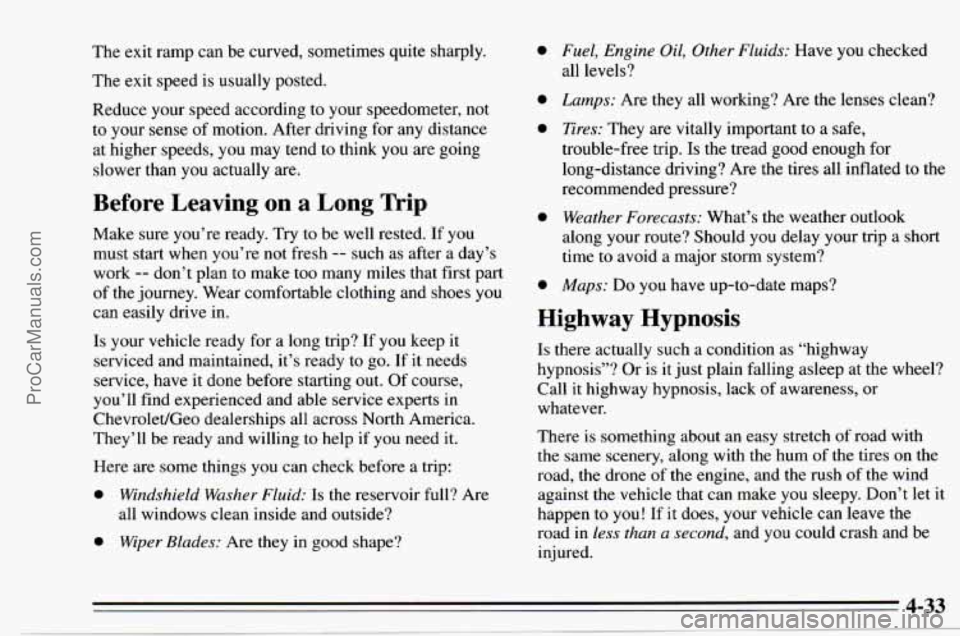
The exit ramp can be curved, sometimes quite sharply.
The
exit speed is usually posted.
Reduce your speed according to your speedometer, not
to your sense of motion. After driving for any distance
at higher speeds, you may tend to think
you are going
slower than
you actually are.
Before Leaving on a Long Trip
Make sure you’re ready. Try to be well rested. If you
must start when you’re not fresh
-- such as after a day’s
work
-- don’t plan to make too many miles that first part
of the journey. Wear comfortable clothing and shoes you
can easily drive in.
Is your vehicle ready for a long trip? If you keep it
serviced and maintained, it’s ready to go. If
it needs
service, have it done before starting out. Of course,
you’ll find experienced and able service experts
in
ChevroletlGeo dealerships all across North America.
They’ll be ready and willing to help if
you need it.
Here are some things you can check before a trip:
0 Windshield Washer Fluid: Is the reservoir full? Are
all windows clean inside and outside?
0 Wiper Blades: Are they in good shape?
0
0
0
0
0
Fuel, Engine Oil, Other Fluids: Have you checked
all levels?
Lamps: Are they all working? Are the lenses clean?
Tires: They are vitally important to a safe,
trouble-free trip.
Is the tread good enough for
long-distance driving? Are the tires all inflated to the
recommended pressure?
Weather Forecasts: What’s the weather outlook
along your route? Should you delay your trip a short
time to avoid a major storm system?
Maps: Do you have up-to-date maps?
Highway Hypnosis
Is there actually such a condition as “highway
hypnosis”? Or is it just plain falling asleep at the wheel?
Call
it highway hypnosis, lack of awareness, or
whatever.
There is something about an easy stretch of road with
the same scenery, along with the hum of the tires on the
road, the drone of the engine, and the rush of the wind
against the vehicle that can make you sleepy. Don’t let
it
happen to you! If it does, your vehicle can leave the
road in
less than a second, and you could crash and be
injured.
ProCarManuals.com
Page 225 of 354
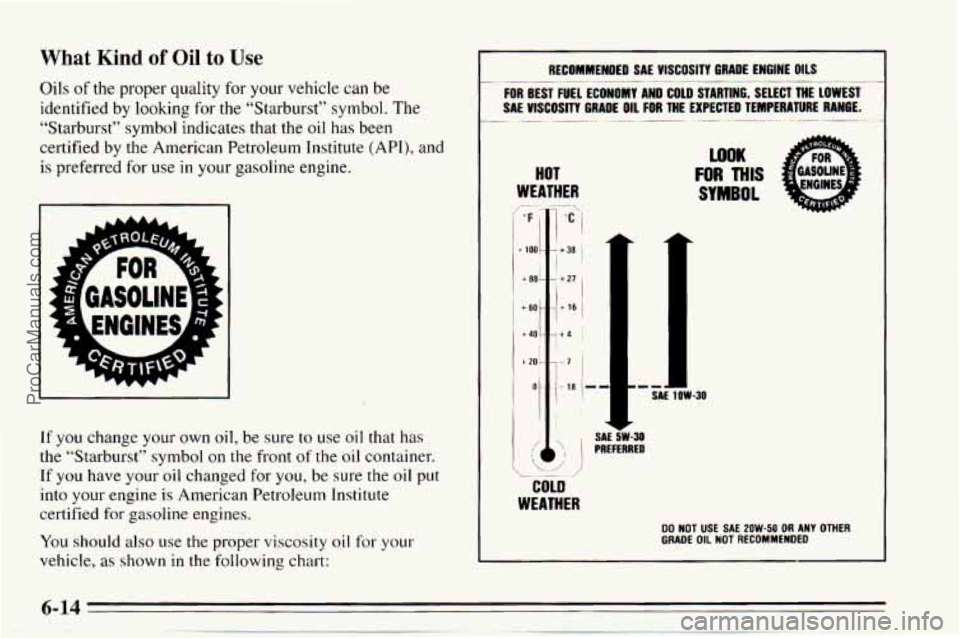
What Kind of Oil to Use
Oils of the proper quality for your vehicle can be
identified by looking
for the “Starburst” symbol. The
“Starburst” symbol indicates that the oil has been
certified by the American Petroleum Institute
(API), and
is preferred for use
in your gasoline engine.
If you change your own oil, be sure to use oil that has
the “Starburst” symbol on the front of the oil container.
If you have your oil changed for you, be sure the oil put
into
your engine is American Petroleum Institute
certified
for gasoline engines.
You should also use the proper viscosity oil for your
vehicle,
as shown in the following chart:
RECOMMENDED SAE VISCOSITY GRADE ENGINE OILS
FOR BEST FUEL ECONOMY AND COLD STARTING, SELECT THE LOWEST
SAE VISCOSITY GRADE OIL FOR THE EXPECTED TEMPERATURE RANGE. __ ~ ~ .~
HOT
WEATHER --
+ 80
+ 60
t 20
-. -. ./ \.. ~ ,.,’ ,
COLD
WEATHER
LOOK
FOR THIS
SYMBOL
SAE ZW-30 PREFERRED
DO NOT USE SAE 2OW-50 OR ANY OTHER
GRADE OIL NOT RECOMMENDED
6-14
ProCarManuals.com
Page 233 of 354
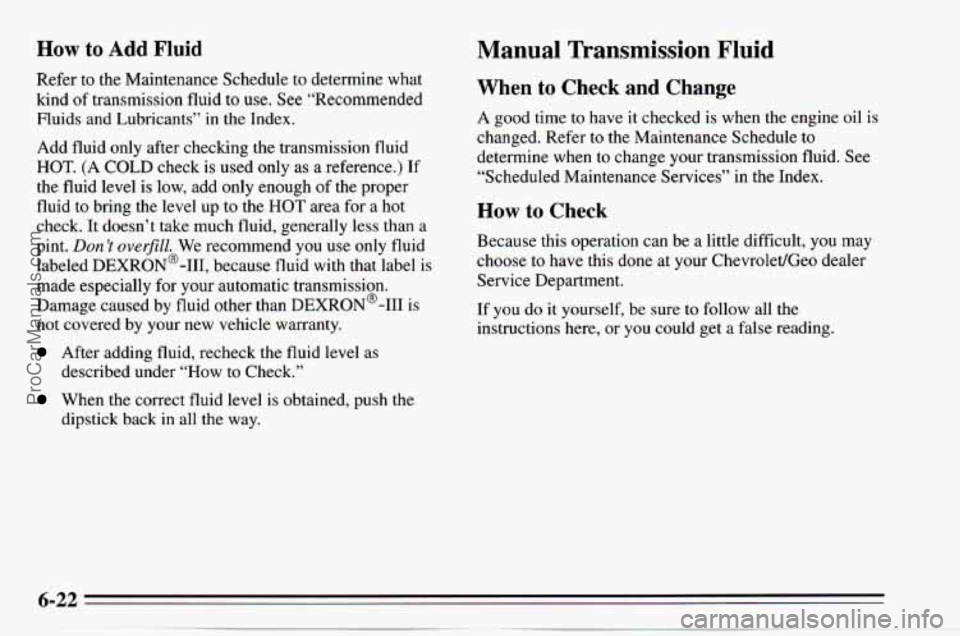
How to Add Fluid Manual Transmission Fluid
Refer to the Maintenance Schedule to determine what
kind
of transmission fluid to use. See “Recommended
Fluids and Lubricants” in the Index.
Add fluid only after checking the transmission fluid
HOT. (A COLD check is used only as a reference.) If
the fluid level is low, add only enough of the proper
fluid to bring the level up to the
HOT area for a hot
check. It doesn’t take much fluid, generally less than a
pint.
Don ’t ove$ZZ. We recommend you use only fluid
labeled DEXRON@-111, because fluid with that label is
made especially for your automatic transmission.
Damage caused by fluid other than DEXRON@-I11 is
not covered by your new vehicle warranty.
After adding fluid, recheck the fluid level as
described under “How to Check.’’
When the correct fluid level is obtained, push the
dipstick back in all the way.
When to Check and Change
A good time to have it checked is when the engine oil is
changed. Refer to the Maintenance Schedule to
determine when to change
your transmission fluid. See
“Scheduled Maintenance Services” in the Index.
How to Check
Because this operation can be a little difficult, you may
choose
to have this done at your Chevrolet/Geo dealer
Service Department.
If you do it yourself, be sure to follow all the
instructions here, or you could get
a false reading.
ProCarManuals.com
Page 236 of 354
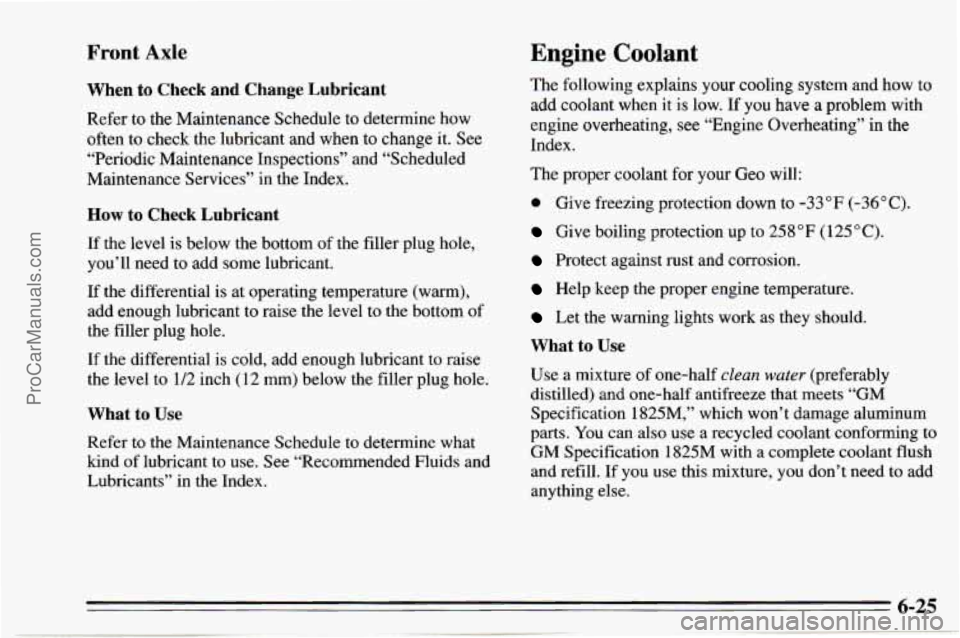
Front Axle Engine Coolant
When to Check and Change Lubricant
Refer to the Maintenance Schedule to determine how
often to check the lubricant and when to change it. See
“Periodic Maintenance Inspections” and “Scheduled
Maintenance Services” in the Index.
How to Check Lubricant
If the level is below the bottom of the filler plug hole,
you’ll need to add some lubricant.
If the differential is at operating temperature (warm),
add enough lubricant to raise the level to the bottom of
the filler plug hole.
If the differential is cold, add enough lubricant to raise
the level to 1/2 inch (12 mm) below the filler plug hole.
What to Use
Refer to the Maintenance Schedule to determine what
kind of lubricant to use. See “Recommended Fluids and
Lubricants” in the Index. The following explains
your cooling
system and how to
add coolant when it is low. If you have a problem with
engine overheating, see “Engine Overheating’’ in the
Index.
The proper coolant for your Geo will:
0 Give freezing protection down to -33°F (-36°C).
Give boiling protection up to 258°F (125°C).
Protect against rust and corrosion.
Help keep the proper engine temperature.
Let the warning lights work as they should.
What to Use
Use a mixture of one-half clean water (preferably
distilled) and one-half antifreeze that meets
“GM
Specification 1825M,” which won’t damage aluminum
parts. You can also use a recycled coolant conforming to
GM Specification 1825M with a complete coolant flush
and refill. If you use this mixture, you don’t need to add
anything else.
ProCarManuals.com
Page 265 of 354
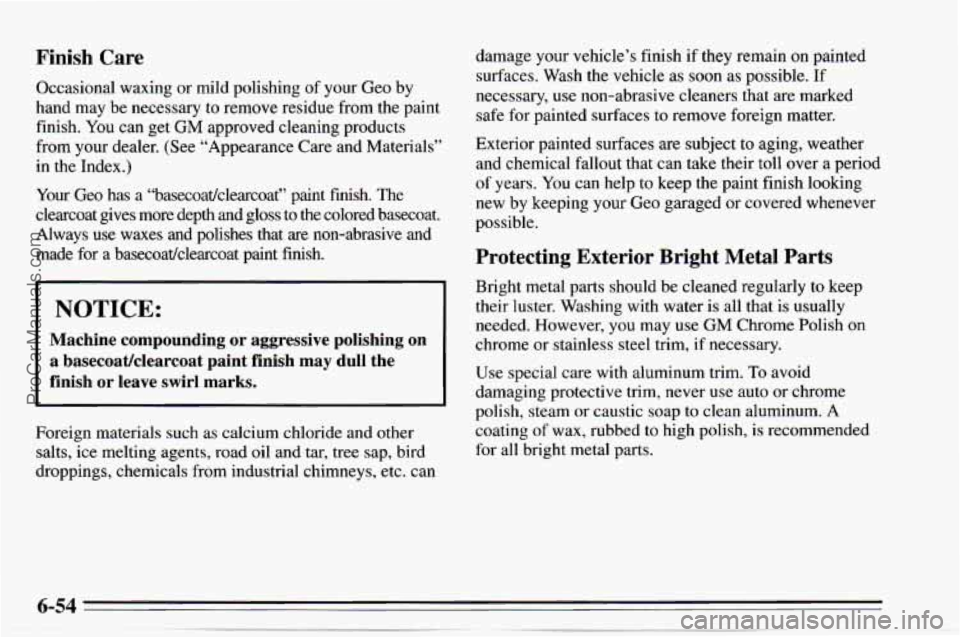
Finish Care
Occasional waxing or mild polishing of your Geo by
hand may be necessary to remove residue from the paint
finish. You can get
GM approved cleaning products
from your dealer. (See “Appearance Care and Materials”
in the Index.)
Your Geo has a “basecoatlclearcoat” paint finish. The
clearcoat gives more depth and gloss to the colored basecoat.
Always use waxes and polishes that are non-abrasive and
made for
a basecoatlclearcoat paint finish.
I NOTICE:
Machine compounding or aggressive polishing on
a basecoat/clearcoat paint finish may dull the
finish or leave swirl marks.
Foreign materials such as calcium chloride and other
salts, ice melting agents, road oil and tar, tree sap, bird
droppings, chemicals from industrial chimneys, etc. can damage
your vehicle’s finish if they remain on painted
surfaces. Wash the vehicle as
soon as possible. If
necessary,
use non-abrasive cleaners that are marked
safe for painted surfaces to remove foreign matter.
Exterior painted surfaces are subject to aging, weather
and chemical
fallout that can take their toll over a period
of years.
You can help to keep the paint finish looking
new by keeping your Geo garaged or covered whenever
possible.
Protecting Exterior Bright Metal Parts
Bright metal parts should be cleaned regularly to keep
their luster. Washing with water is all that is usually
needed. However, you may
use GM Chrome Polish on
chrome or stainless steel trim, if necessary.
Use special care with aluminum trim.
To avoid
damaging protective trim, never use auto or chrome
polish, steam or caustic soap to clean aluminum.
A
coating of wax, rubbed to high polish, is recommended
for all bright metal parts.
ProCarManuals.com
Page 278 of 354
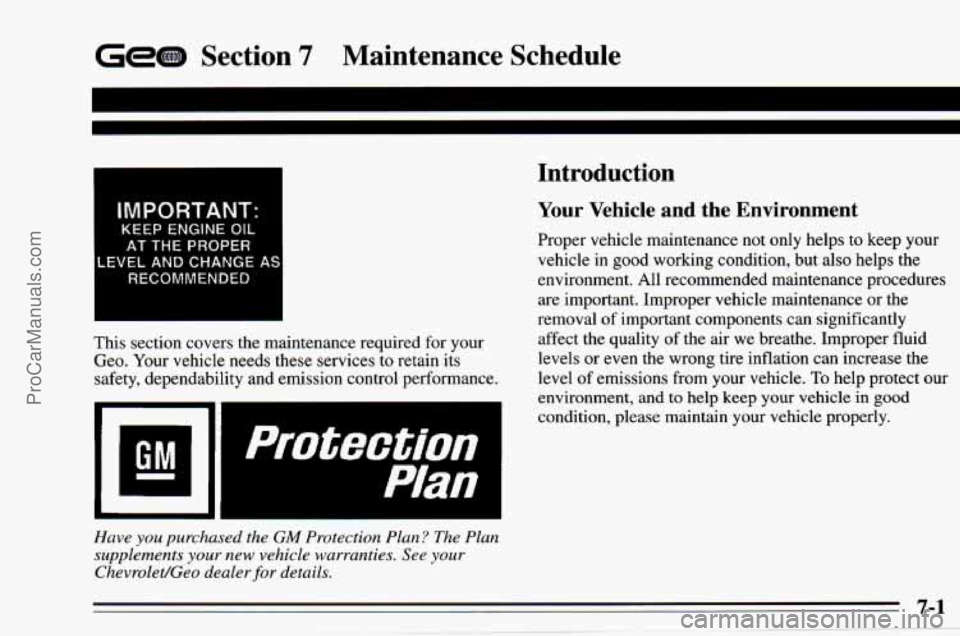
Gem Section 7 Maintenance Schedule
IMPORTANT:
KEEP ENGINE OIL
AT THE PROPER
RECOMMENDED
This section covers the maintenance required for your
Geo. Your vehicle needs these services to retain
its
safety, dependability and emission control performance.
Introduction
Your Vehicle and the Environment
Proper vehicle maintenance not only helps to keep your
vehicle
in good working condition, but also helps the
environment. All recommended maintenance procedures
are important. Improper vehicle maintenance or the
removal
of important components can significantly
affect the quality of the
air we breathe. Improper fluid
levels or even the wrong tire inflation can increase the
level of emissions from your vehicle.
To help protect our
environment, and to help keep your vehicle in good
condition, please maintain your vehicle properly.
Have you purchased the GM Protection Plan .? The Plan
supplements your new vehicle warranties. See your
Chevrolet/Geo dealersfor details.
7-1
ProCarManuals.com
Page 285 of 354
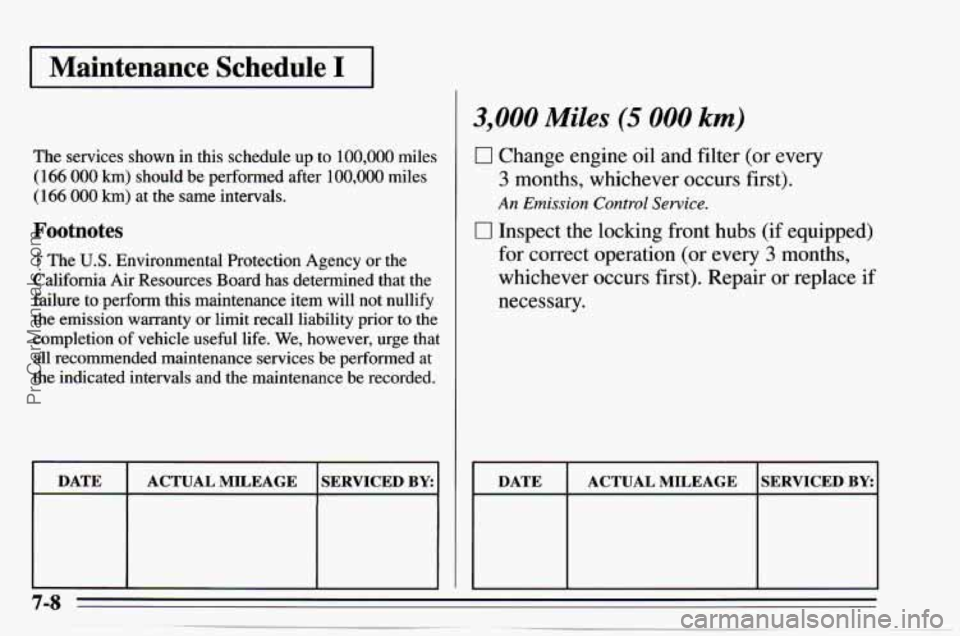
I Maintenance Schedule I I
The services shown in this schedule up to 100,000 miles
(166 000 km) should be performed after 100,000 miles
( 166 000 km) at the same intervals.
Footnotes
The U.S. Environmental Protection Agency or the
California Air Resources
Board has determined that the
failure
to perform this maintenance item will not nullify
the emission warranty or limit recall liability prior to the
completion
of vehicle useful life. We, however, urge that
all recommended maintenance services be performed at
the indicated intervals and the maintenance be recorded.
DATE
SERVICED BY: ACTUAL MILEAGE
3,000 Miles (5 000 km)
0 Change engine oil and filter (or every
3 months, whichever occurs first).
An Emission Control Service.
0 Inspect the locking front hubs (if equipped)
for correct operation (or every
3 months,
whichever occurs first). Repair or replace
if
necessary.
DATE ACTUAL MILEAGE
€
SERVICED BY
ProCarManuals.com
Page 310 of 354

I Maintenance Schedule I1 I
7,500 Miles (12 500 km)
The services shown in this schedule up to 100,000 miles
( 166 000 km) should be performed after 100,000 miles
(166 000 km) at the same intervals.
Footnotes
The U.S. Environmental Protection Agency or the
California Air Resources Board has determined that the
failure to perform this maintenance item will not nullify
the emission warranty or limit recall liability prior
to the
completion
of vehicle useful life. We, however, urge that
all recommended maintenance services be performed at
the indicated intervals and the maintenance be recorded.
0 Change engine oil and filter (or every
7.5 months, whichever occurs first).
An Emission Control Service.
0 Rotate tires. See “Tire Inspection and
Rotation” in the Index for proper rotation
pattern and additional information.
0 Inspect the locking front hubs (if equipped)
for correct operation (or ever
3 months,
whichever occurs first). Repair or replace if
necessary.
I DATE I ACTUAL MILEAGE ISERVICED BY: I
ProCarManuals.com
Page 331 of 354

Part D: Recommended Fluids and
Lubricants
NOTE: Fluids and lubricants identified below by name,
part number or specification may be obtained from your
GM dealer.
I USAGE
1 Engine Oil
F Engine Coolant
FLUIDLUBRICANT
Engine oil with the American
Petroleum Institute Certified For
Gasoline Engines “Starburst”
symbol of the proper viscosity.
To
determine the preferred viscosity
for your vehicle’s engine, see
“Engine Oil” in the Index.
50/50 mixture of water (preferably
distilled) and
good quality
ethylene glycol base antifreeze
(GM Part No. 1052753 or
equivalent) conforming to
GM
Specification 1825M or approved
recycled coolant conforming
to
GM Specification 1825M.
USAGE
FLUIDLUBRICANT
Hydraulic Brake Delco Supreme 11 @ Brake Fluid
System (GM
Part No. 1052535 or
equivalent DOT-3 brake fluid).
Parking Brake
Chassis lubricant (GM Part
Guides
No. 1052497 or equivalent) or
lubricant meeting requirements
of
NLGI Grade 2, Category LB or
GC-LB.
Power Steering DEXRON@-111 Automatic
System Transmission Fluid.
Manual
SAE 75W-90 GL-4 (GM Part
Transmission
No. 12346 190 Castrol@ S yntorq
GL-4 or equivalent) or
SAE
75W-90 GL-5 Gear Lubricant.
Automatic DEXRON@-111 Automatic
Transmission Transmission Fluid.
Key Lock Lubricate with Multi-Purpose
Cylinders Lubricant (GM
Part No. 12345120)
or synthetic SAE 5W-30 engine
oil.
7-54
ProCarManuals.com
Page 332 of 354
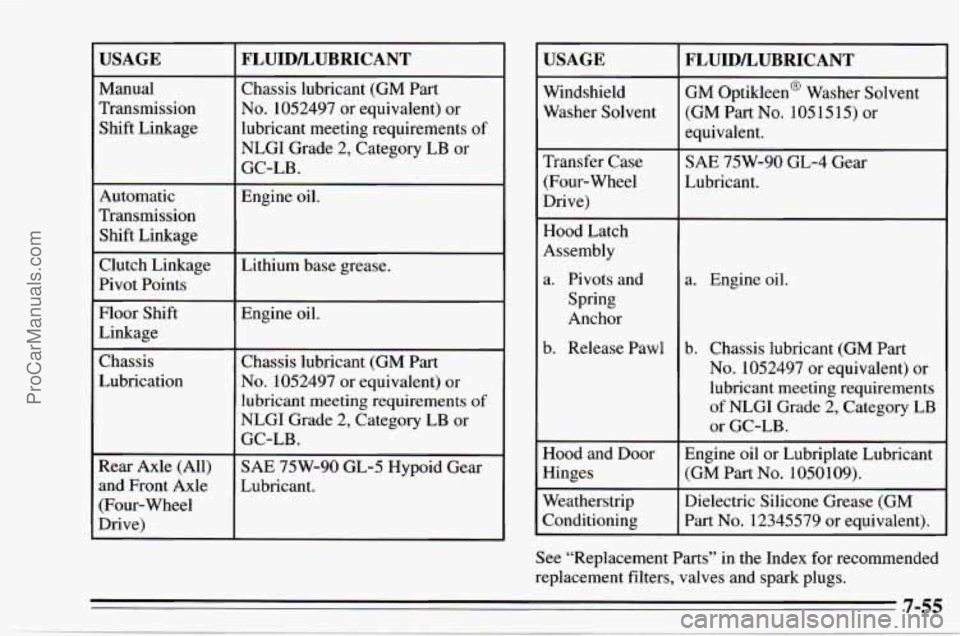
USAGE
Manual
Transmission
Shift Linkage
Automatic
Transmission
Shift Linkage
Clutch Linkage
Pivot Points
Floor Shift
Linkage
Chassis
Lubrication
Rear Axle (All)
and Front Axle
(Four-wheel
Drive)
FLUIDLUBRICANT
Chassis lubricant (GM Part
No. 1052497 or equivalent) or
lubricant meeting requirements
of
NLGI Grade 2, Category LB or
Engine oil.
GC-LB.
Lithium base grease.
Engine oil.
Chassis lubricant (GM Part
No. 1052497 or equivalent) or
lubricant meeting requirements
of
NLGI Grade 2, Category LB or
~~~~
GC-LB.
SAE 75W-90 GL-5 Hypoid Gear
Lubricant.
USAGE
Windshield
Washer Solvent
Transfer Case (Four- Wheel
Drive)
Hood Latch
Assembly
a. Pivots and Spring
Anchor
b. Release Pawl
Hood and Door Hinges
Weatherstrip
Conditioning
FLUIDLUBRICANT
GM Optikleen@ Washer Solvent
(GM Part
No. 1051515) or
equivalent.
SAE 75W-90 GL-4 Gear
Lubricant.
a. Engine oil.
b. Chassis lubricant (GM Part
No. 1052497 or equivalent) or
lubricant meeting requirements
of NLGI Grade 2, Category LB
or GC-LB.
Engine oil or Lubriplate Lubricant (GM Part No. 1050109).
Dielectric Silicone Grease-(GM
Part
No. 12345579 or equivalent).
See “Replacement Parts” in the Index for recommended
replacement filters, valves and spark plugs.
ProCarManuals.com